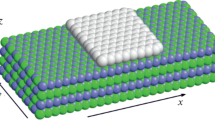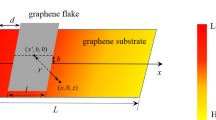Abstract
Recognizing that either the retarded van der Walls (sometimes called the Casimir) or the full van der Walls force always acts between two flat surfaces that are in close proximity to each other, we analyze the stiction phenomenon in nanoelectromechanical systems (NEMS) composed of a single layer of graphene suspended over a stationary rigid substrate of graphene by using both molecular dynamics (MD) simulations and a linear elasticity theory. Stiction occurs when the initial gap between the deformable and the stationary electrodes of a NEMS is small enough for the two electrodes to touch each other in the absence of any applied potential difference between them. The value of the initial gap at stiction is called the critical gap and determines the fabricability of the device. In this work, an NEMS is modelled as a pre-stressed clamped atomic graphene structure in the form of either a rectangular strip or a solid/annular circular initially flat disk suspended over a rigid flat substrate and the critical gap found as a function of the prestress. Both methods involve different challenges – the MD work requires properly estimating the Casimir force and the continuum problem has a deflection-dependent external force. It is shown that results from the two approaches qualitatively agree with each other. For the continuum problem we provide a simple expression for estimating limiting dimensions of the NEMS.



Similar content being viewed by others
References
Bordag, M., Mohideen, U., Mostepanenko, V.M.: New developments in the Casimir effect. Phys. Rep. 353, 1–205 (2001)
Lifshitz, E.M.: The theory of molecular attractive forces between solids. Sov. Phys. 2 (1956)
Klimchitskaya, G.L., Mohideen, U., Mostepanenko, V.M.: Casimir and van der Waals forces between two plates or a sphere (lens) above a plate made of real metals. Phys. Rev. A 61, 062107 (2000)
Zhang, W-M., Yan, H., Peng, Z-K., Meng, G.: Electrostatic pull-in instability in MEMS/NEMS: a review. Sens. Actuators A, Phys. 214, 187–218 (2014)
Yang, X.P., Zhang, M.L.: Review of flexible microelectromechanical system sensors and devices. Nanotechnol. Precis. Eng. 4, 025001 (2021)
Serry, F.M., Walliser, D., Maclay, G.J.: The role of the Casimir effect in the static deflection and stiction of membrane strips in microelectromechanical systems (MEMS). J. Appl. Phys. 84, 2501–2506 (1998)
Batra, R.C., Porfiri, M., Spinello, D.: Effects of Casimir force on pull-in instability in micromembranes. Europhys. Lett. 77, 20010 (2007)
Batra, R.C., Porfiri, M., Spinello, D.: Reduced-order models for microelectromechanical rectangular and circular plates incorporating the Casimir force. Int. J. Solids Struct. 45, 3558–3583 (2008)
Sircar, A., Patra, P.K., Batra, R.C.: Casimir force and its effects on pull-in instability modelled using molecular dynamics simulations. Proc. R. Soc. A 476, 20200311 (2020)
Frenkel, D., Smit, B.: Understanding Molecular Simulation: From Algorithms to Applications, vol. 1. Elsevier, Amsterdam (2001)
Lin, W.H., Zhao, Y.P.: Casimir effect on the pull-in parameters of nanometer switches. Microsyst. Technol. 11, 80–85 (2005)
Landau, L.D.: Electrodynamics of Continuous Media. Landau and Lifshitz Course of Theoretical Physics, Vol. 8 (1984)
Milonni, P.W.: The Quantum Vacuum: An Introduction to Quantum Electrodynamics. Academic press, San Diego (2013)
Fosco, C.D., Lombardo, F.C., Mazzitelli, F.D.: Proximity force approximation for the Casimir energy as a derivative expansion. Phys. Rev. D 84, 105031 (2011)
Tersoff, J.J.: Modeling solid-state chemistry: interatomic potentials for multicomponent systems. Phys. Rev. B 39, 5566 (1989)
Lindsay, L., Broido, D.A.: Optimized Tersoff and Brenner empirical potential parameters for lattice dynamics and phonon thermal transport in carbon nanotubes and graphene. Phys. Rev. B 81, 205441 (2010)
Mortazavi, B., Ahzi, S.: Thermal conductivity and tensile response of defective graphene: a molecular dynamics study. Carbon 63, 460–470 (2013)
Plimpton, S.: Fast parallel algorithms for short-range molecular dynamics. J. Comput. Phys. 117, 1–19 (1955)
Hamaker, H.C.: The London—van der Waals attraction between spherical particles. Physica 4, 1058–1072 (1937)
Wang, C.Y., Wang, C.M.: Structural Vibration: Exact Solutions for Strings, Membranes, Beams, and Plates. CRC Press, Boca Raton (2013)
Thompson, A.P., Plimpton, S.J., Mattson, W.: General formulation of pressure and stress tensor for arbitrary many-body interaction potentials under periodic boundary conditions. J. Chem. Phys. 131(15), 154107 (2009)
Cormier, J., Rickman, J.M., Delph, T.J.: Stress calculation in atomistic simulations of perfect and imperfect solids. J. Appl. Phys. 89(1), 99–104 (2001)
Gupta, S.S., Batra, R.C.: Elastic properties and frequencies of free vibrations of single-layer graphene sheets. J. Comput. Theor. Nanosci. 7(10), 2151–2164 (2010)
Acknowledgements
Authors are indebted to an anonymous reviewer and the Editor (Professor Roger Fosdick) for their constructive comments on the earlier version of the manuscript that have enormously improved the presentation of the work. The authors are solely responsible for errors and omissions, if any, in the paper.
Author information
Authors and Affiliations
Additional information
RCB dedicates this work to Millard F. Beatty with immense respect and best wishes on his 90th Birthday
Publisher’s Note
Springer Nature remains neutral with regard to jurisdictional claims in published maps and institutional affiliations.
Appendix
Appendix
The virial stress on an atom \(i\) is given by [21]:
In Eq. (A.1) \(m_{i}\) is the mass of atom \(i\), \(\boldsymbol{x_{i}}\) its present position, \(\dot{\boldsymbol{u_{i}}}\) its present velocity, \(\boldsymbol{x}_{ij} = \boldsymbol{x}_{i} - \boldsymbol{x}_{j}\), ⊗ denotes the tensor or the dyadic product between two vectors, \(\varPi _{\mathrm{i}}\) is the volume assigned to atom \(i\), and \(f_{ij}\) equals the interatomic force between atoms \(i\) and \(j\). We calculate the prestress as the average of the virial stresses for all atoms in layer \(A\), e.g., see Cormier et al. [22].
The software LAMMPS outputs the value \(\varPi _{i} \sigma _{i}\) for each atom \(i\). To avoid assigning a value to \(h\) for a single-layer graphene sheet [23], we plot the initial critical gap against the quantity ‘\(\sigma _{0} h\)’ for both the MD simulations and the analysis of the linearly elastic problem.
Rights and permissions
About this article
Cite this article
Batra, R.C., Sircar, A. Analysis of Stiction in Nanoelectromechanical Systems Using Molecular Dynamics Simulations and Continuum Theory. J Elast 151, 143–157 (2022). https://doi.org/10.1007/s10659-022-09887-3
Received:
Accepted:
Published:
Issue Date:
DOI: https://doi.org/10.1007/s10659-022-09887-3
Keywords
- Stiction
- Retarded van der Walls or the Casimir force
- van der Waals force
- Molecular dynamics simulations
- Linearly elastic membrane




